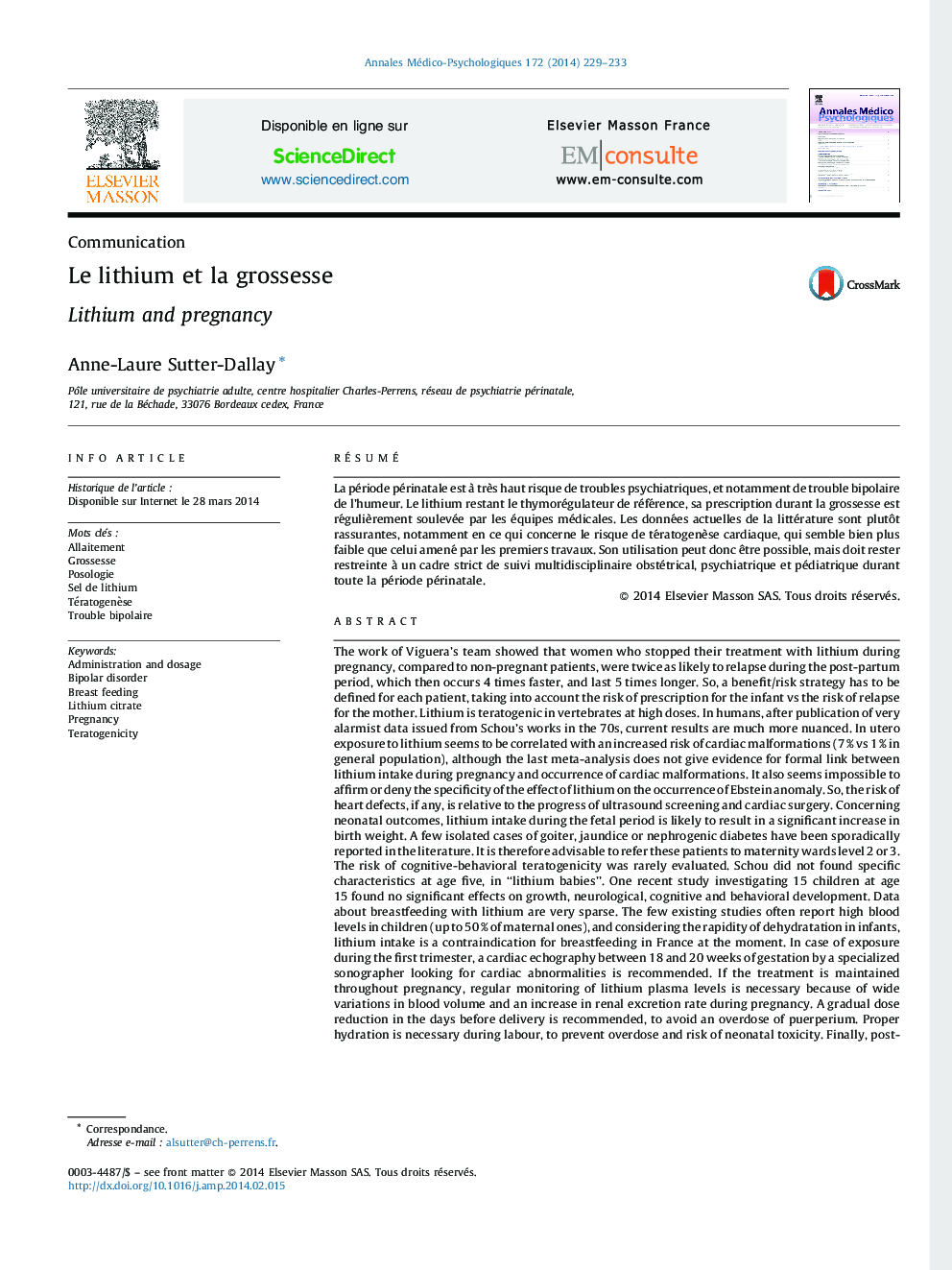| کد مقاله | کد نشریه | سال انتشار | مقاله انگلیسی | نسخه تمام متن |
|---|---|---|---|---|
| 312452 | 534218 | 2014 | 5 صفحه PDF | دانلود رایگان |
RésuméLa période périnatale est à très haut risque de troubles psychiatriques, et notamment de trouble bipolaire de l’humeur. Le lithium restant le thymorégulateur de référence, sa prescription durant la grossesse est régulièrement soulevée par les équipes médicales. Les données actuelles de la littérature sont plutôt rassurantes, notamment en ce qui concerne le risque de tératogenèse cardiaque, qui semble bien plus faible que celui amené par les premiers travaux. Son utilisation peut donc être possible, mais doit rester restreinte à un cadre strict de suivi multidisciplinaire obstétrical, psychiatrique et pédiatrique durant toute la période périnatale.
The work of Viguera's team showed that women who stopped their treatment with lithium during pregnancy, compared to non-pregnant patients, were twice as likely to relapse during the post-partum period, which then occurs 4 times faster, and last 5 times longer. So, a benefit/risk strategy has to be defined for each patient, taking into account the risk of prescription for the infant vs the risk of relapse for the mother. Lithium is teratogenic in vertebrates at high doses. In humans, after publication of very alarmist data issued from Schou's works in the 70s, current results are much more nuanced. In utero exposure to lithium seems to be correlated with an increased risk of cardiac malformations (7 % vs 1 % in general population), although the last meta-analysis does not give evidence for formal link between lithium intake during pregnancy and occurrence of cardiac malformations. It also seems impossible to affirm or deny the specificity of the effect of lithium on the occurrence of Ebstein anomaly. So, the risk of heart defects, if any, is relative to the progress of ultrasound screening and cardiac surgery. Concerning neonatal outcomes, lithium intake during the fetal period is likely to result in a significant increase in birth weight. A few isolated cases of goiter, jaundice or nephrogenic diabetes have been sporadically reported in the literature. It is therefore advisable to refer these patients to maternity wards level 2 or 3. The risk of cognitive-behavioral teratogenicity was rarely evaluated. Schou did not found specific characteristics at age five, in “lithium babies”. One recent study investigating 15 children at age 15 found no significant effects on growth, neurological, cognitive and behavioral development. Data about breastfeeding with lithium are very sparse. The few existing studies often report high blood levels in children (up to 50 % of maternal ones), and considering the rapidity of dehydratation in infants, lithium intake is a contraindication for breastfeeding in France at the moment. In case of exposure during the first trimester, a cardiac echography between 18 and 20 weeks of gestation by a specialized sonographer looking for cardiac abnormalities is recommended. If the treatment is maintained throughout pregnancy, regular monitoring of lithium plasma levels is necessary because of wide variations in blood volume and an increase in renal excretion rate during pregnancy. A gradual dose reduction in the days before delivery is recommended, to avoid an overdose of puerperium. Proper hydration is necessary during labour, to prevent overdose and risk of neonatal toxicity. Finally, post-partum daily dosages of plasmatic lithium levels are needed, until stable levels are available. Note that some authors propose a short therapeutic window in the days before the birth, with a resumption of treatment at birth. So prescribing lithium, when needed during pregnancy is possible, but inside a collaborative multidisciplinary network.
Journal: Annales Médico-psychologiques, revue psychiatrique - Volume 172, Issue 3, May 2014, Pages 229–233
